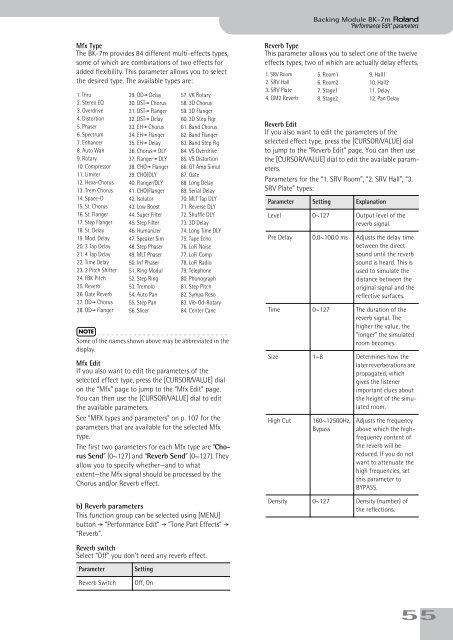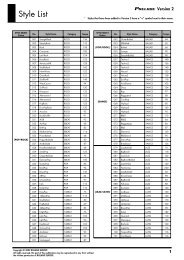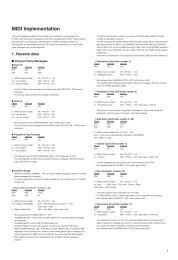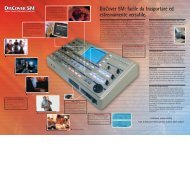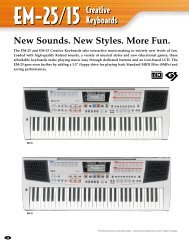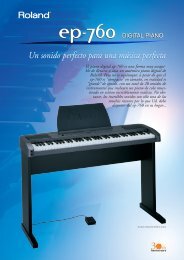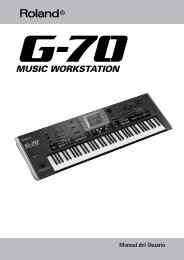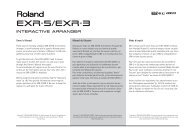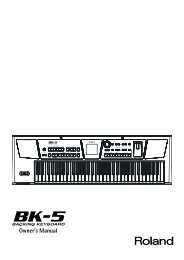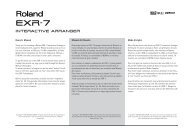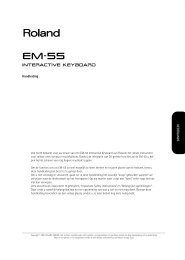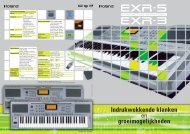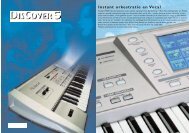BK-7m_OM.pdf - Roland
BK-7m_OM.pdf - Roland
BK-7m_OM.pdf - Roland
Create successful ePaper yourself
Turn your PDF publications into a flip-book with our unique Google optimized e-Paper software.
Backing Module <strong>BK</strong>-<strong>7m</strong> r<br />
‘Performance Edit’ parameters<br />
Mfx Type<br />
The <strong>BK</strong>-<strong>7m</strong> provides 84 different multi-effects types,<br />
some of which are combinations of two effects for<br />
added flexibility. This parameter allows you to select<br />
the desired type. The available types are:<br />
1. Thru<br />
2. Stereo EQ<br />
3. Overdrive<br />
4. Distortion<br />
5. Phaser<br />
6. Spectrum<br />
7. Enhancer<br />
8. Auto Wah<br />
9. Rotary<br />
10. Compressor<br />
11. Limiter<br />
12. Hexa-Chorus<br />
13. Trem Chorus<br />
14. Space-D<br />
15. St. Chorus<br />
16. St. Flanger<br />
17. Step Flanger<br />
18. St. Delay<br />
19. Mod. Delay<br />
20. 3 Tap Delay<br />
21. 4 Tap Delay<br />
22. Time Delay<br />
23. 2 Pitch Shifter<br />
24. F<strong>BK</strong> Pitch<br />
25. Reverb<br />
26. Gate Reverb<br />
27. OD‰ Chorus<br />
28. OD‰ Flanger<br />
29. OD‰ Delay<br />
30. DST‰ Chorus<br />
31. DST‰ Flanger<br />
32. DST‰ Delay<br />
33. EH‰ Chorus<br />
34. EH‰ Flanger<br />
35. EH‰ Delay<br />
36. Chorus‰ DLY<br />
37. Flanger‰ DLY<br />
38. CHO‰ Flanger<br />
39. CHO/DLY<br />
40. Flanger/DLY<br />
41. CHO/Flanger<br />
42. Isolator<br />
43. Low Boost<br />
44. Super Filter<br />
45. Step Filter<br />
46. Humanizer<br />
47. Speaker Sim<br />
48. Step Phaser<br />
49. MLT Phaser<br />
50. Inf Phaser<br />
51. Ring Modul<br />
52. Step Ring<br />
53. Tremolo<br />
54. Auto Pan<br />
55. Step Pan<br />
56. Slicer<br />
57. VK Rotary<br />
58. 3D Chorus<br />
59. 3D Flanger<br />
60. 3D Step Flgr<br />
61. Band Chorus<br />
62. Band Flanger<br />
63. Band Step Flg<br />
64. VS Overdrive<br />
65. VS Distortion<br />
66. GT Amp Simul<br />
67. Gate<br />
68. Long Delay<br />
69. Serial Delay<br />
70. MLT Tap DLY<br />
71. Reverse DLY<br />
72. Shuffle DLY<br />
73. 3D Delay<br />
74. Long Time DLY<br />
75. Tape Echo<br />
76. LoFi Noise<br />
77. LoFi Comp<br />
78. LoFi Radio<br />
79. Telephone<br />
80. Phonograph<br />
81. Step Pitch<br />
82. Sympa Reso<br />
83. Vib-Od-Rotary<br />
84. Center Canc<br />
NOTE<br />
Some of the names shown above may be abbreviated in the<br />
display.<br />
Mfx Edit<br />
If you also want to edit the parameters of the<br />
selected effect type, press the [CURSOR÷VALUE] dial<br />
on the “Mfx” page to jump to the “Mfx Edit” page.<br />
You can then use the [CURSOR÷VALUE] dial to edit<br />
the available parameters.<br />
See “MFX types and parameters” on p. 107 for the<br />
parameters that are available for the selected Mfx<br />
type.<br />
The first two parameters for each Mfx type are “Chorus<br />
Send” (0~127) and “Reverb Send” (0~127). They<br />
allow you to specify whether—and to what<br />
extent—the Mfx signal should be processed by the<br />
Chorus and/or Reverb effect.<br />
b) Reverb parameters<br />
This function group can be selected using [MENU]<br />
button ‰ “Performance Edit” ‰ “Tone Part Effects” ‰<br />
“Reverb”.<br />
Reverb Type<br />
This parameter allows you to select one of the twelve<br />
effects types, two of which are actually delay effects.<br />
1. SRV Room<br />
2. SRV Hall<br />
3. SRV Plate<br />
4. GM2 Reverb<br />
Reverb Edit<br />
If you also want to edit the parameters of the<br />
selected effect type, press the [CURSOR÷VALUE] dial<br />
to jump to the “Reverb Edit” page. You can then use<br />
the [CURSOR÷VALUE] dial to edit the available parameters.<br />
Parameters for the “1. SRV Room”, “2. SRV Hall”, “3.<br />
SRV Plate” types:<br />
Parameter Setting Explanation<br />
Level 0~127 Output level of the<br />
reverb signal.<br />
Pre Delay 0.0~100.0 ms Adjusts the delay time<br />
between the direct<br />
sound until the reverb<br />
sound is heard. This is<br />
used to simulate the<br />
distance between the<br />
original signal and the<br />
reflective surfaces.<br />
Time 0~127 The duration of the<br />
reverb signal. The<br />
higher the value, the<br />
“longer” the simulated<br />
room becomes.<br />
Size 1~8 Determines how the<br />
later reverberations are<br />
propagated, which<br />
gives the listener<br />
important clues about<br />
the height of the simulated<br />
room.<br />
High Cut<br />
5. Room1<br />
6. Room2<br />
7. Stage1<br />
8. Stage2<br />
160~12500Hz,<br />
Bypass<br />
9. Hall1<br />
10. Hall2<br />
11. Delay<br />
12. Pan Delay<br />
Adjusts the frequency<br />
above which the highfrequency<br />
content of<br />
the reverb will be<br />
reduced. If you do not<br />
want to attenuate the<br />
high frequencies, set<br />
this parameter to<br />
BYPASS.<br />
Density 0~127 Density (number) of<br />
the reflections.<br />
Reverb switch<br />
Select “Off” you don’t need any reverb effect.<br />
Parameter<br />
Reverb Switch<br />
Setting<br />
Off, On<br />
55


